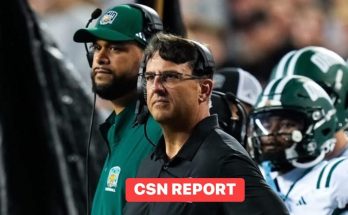NFL insider Ian Rapoport didn’t just drop a tidbit on The Pat McAfee Show — he shifted the narrative entirely. When he spoke about the Cincinnati Bengals’ intentions regarding star pass rusher Trey Hendrickson, it was more than just an offhand remark. It was a clear, pointed message directed at fans, analysts, and other players across the league: the Bengals do take care of their own, and they want the world to know it. The quote — “The Cincinnati Bengals are working on it. They’d like to keep him in the building, they’d like to pay him… and they’d like people to stop saying they don’t pay their guys” — hits several key points that go far beyond Hendrickson’s future. It touches on legacy, perception, contract politics, and a team trying to reframe its image amid a pivotal window of contention.
Trey Hendrickson is not just another pass rusher. Since arriving in Cincinnati in 2021 after a breakout season with the New Orleans Saints, Hendrickson has not only lived up to the hype but exceeded it. In his three years with the Bengals, he’s become one of the most disruptive edge defenders in the league, consistently posting high sack totals, creating pressures, and being a cornerstone of Lou Anarumo’s deceptively complex defensive schemes. For a team like Cincinnati, which isn’t traditionally known for massive free-agent splurges or making blockbuster trades, hitting on a player like Hendrickson — and doing so in free agency — was a landmark move. It signaled a shift from the conservative reputation they had long carried.
But with success comes cost. And Hendrickson’s cost is going up.
He’s made no secret about wanting more security and financial reward, especially after watching less accomplished players across the league land monster contracts. He signed a four-year, $60 million deal with the Bengals back in 2021. That contract has aged very well for the team, but not so much for Hendrickson. Since then, the market for elite pass rushers has exploded, with players like Nick Bosa, Myles Garrett, and now Brian Burns getting eye-watering contracts north of $25 million per year. While Hendrickson may not have the same name-brand appeal as Bosa or Garrett, his production and film tell a story that any defensive coordinator would rave about. His ability to win off the edge with speed, power, and relentless effort has made him one of the most feared defenders in the AFC.
The Bengals know that, and that’s why they’re working to keep him.
But the subtext of Rapoport’s statement runs deeper than just a negotiation update. His final line — “they’d like people to stop saying they don’t pay their guys” — is not accidental. It addresses a long-standing criticism of the Bengals franchise, one that has lingered for decades: that they’re cheap, slow to pay, and reluctant to reward their own stars. For years, this reputation haunted Cincinnati. Players like Carson Palmer publicly aired frustrations. Critics pointed to a lack of investment in infrastructure, support staff, and even basic amenities in the team facilities. The Bengals, fair or not, were often the punchline when it came to discussions about old-school ownership unwilling to adapt to the times.
But things have been changing.
The Joe Burrow era has forced a cultural shift in Cincinnati, and the front office has had no choice but to adapt. After drafting Burrow first overall in 2020, the Bengals have slowly but surely begun to embrace the modern NFL. That includes investing more heavily in free agents, increasing their presence in analytics and player development, and most importantly — spending money to keep the core together. The Burrow extension was a major milestone, both in terms of raw dollars and what it represented symbolically. The Bengals were saying, loud and clear, that they intended to win — and spend — like a contender.
But Burrow is one piece. The broader challenge lies in keeping the roster intact. Ja’Marr Chase, Tee Higgins, DJ Reader, Logan Wilson, and Hendrickson are all part of the core that has led the Bengals to two AFC Championship games in the past three seasons. Balancing all those contract situations is a near-impossible task in today’s NFL, especially with the salary cap still presenting limitations, no matter how creative front offices get. What makes Hendrickson’s case unique is that his contract is not expiring this year — he’s still under contract for 2024 and 2025. So why is his situation suddenly so pressing?
Because Hendrickson reportedly wants more guaranteed money, more upfront security, and possibly a new structure altogether. He’s been a consummate pro, has played through injury, and has outproduced his deal. That gives him leverage, even if he’s not in a typical “contract year.” The Bengals, on the other hand, can look at his age — 29 — and reasonably wonder how much longer he’ll be performing at this level. But the risk of losing him or creating locker-room tension may outweigh the financial hesitation. Especially when you’re a team trying to convince its stars — current and future — that you’ll reward them appropriately.
And that’s where Rapoport’s comment strikes the deepest chord. The perception that the Bengals don’t pay their stars isn’t just about Hendrickson. It’s about the ripple effect. Players talk. Agents talk. When one team gains a reputation for underpaying or dragging their feet in negotiations, that perception spreads like wildfire in the offseason ecosystem. Players may still sign there, but it changes the tone of every conversation. It can limit the Bengals’ ability to retain talent, to lure elite free agents, and even to keep harmony within the building. So yes — they want to pay Hendrickson. But they also want to send a message to the rest of the league: Cincinnati is not the same franchise it was ten years ago.
There’s also a strategic element to keeping Hendrickson happy. Lou Anarumo’s defensive system relies heavily on front-end pressure. Unlike more blitz-heavy schemes that mask deficiencies with volume, Anarumo leans into disguise, rotation, and surgical pressure from his front four. Hendrickson is not just a cog in that machine — he’s the spark plug. Losing him would force a complete redesign of the defense, especially with Sam Hubbard being more of a complementary presence rather than a game-changing pass rusher. You don’t just replace 14-sack seasons with a mid-round pick or a veteran flyer. That’s not how contenders operate.
It also sends a message to the other players waiting on deals. Tee Higgins is playing on the franchise tag, and while that situation remains murky, his teammates are watching how it’s handled. So too are guys like Ja’Marr Chase, who will soon command a record-breaking extension. If they see that Cincinnati is slow to reward a player like Hendrickson — one who has gone above and beyond and isn’t even demanding a market-resetting deal — it may color their own perceptions of what loyalty means in that building. Paying Hendrickson is about more than sacks. It’s about signaling that effort, performance, and leadership will be rewarded.
And there’s also the fanbase to consider. Bengals fans have waited decades for a roster like this. They’ve watched the team go from laughingstock to legitimate Super Bowl contender in just a few short years. The city has rallied around players like Burrow, Chase, Wilson, and Hendrickson. Letting any of them walk — especially without a fight — would be seen as a betrayal of that progress. It would reinforce the very narrative the Bengals are working to dispel. Rewarding Hendrickson would buy goodwill, both in the locker room and in the stands.
From a cap standpoint, the Bengals are actually in a decent position. Burrow’s extension was structured in a way that front-loaded a lot of guarantees and minimized cap hits in the early years. They have flexibility to move money around, to front-load deals, and to restructure contracts as needed. Giving Hendrickson a new deal with more guaranteed money or even a short extension with bonus-heavy structure would not cripple their cap. It’s a manageable situation — if they want to make it work.
Ultimately, this is about identity. Are the Bengals going to behave like the team they were — or the team they claim they are now? The old Bengals would have let Hendrickson play out his deal, maybe even trade him at peak value if things got tense. The new Bengals? They’re supposed to be different. They’re supposed to be smart, aggressive, and intentional about building a championship-caliber culture. Paying Hendrickson won’t guarantee a Super Bowl, but it does reinforce a foundation of trust and accountability that’s crucial for long-term success.
So when Ian Rapoport said, “They’d like to pay him,” that’s not just agent-speak or media filler. It’s a signal. The Bengals are aware of their reputation. They’re aware of what’s at stake. They know that actions speak louder than words — especially when those actions come in the form of guaranteed money and commitment. And if they follow through, they won’t just be keeping one of their best defenders — they’ll be reinforcing the cultural transformation that has been quietly taking place inside Paul Brown Stadium. Hendrickson’s deal might be one player’s story, but it’s also the latest chapter in a franchise rewriting its legacy.



